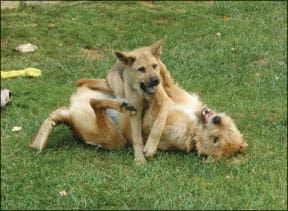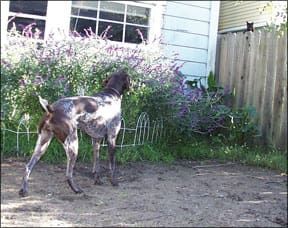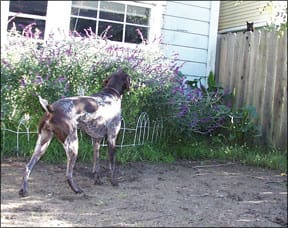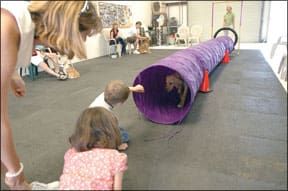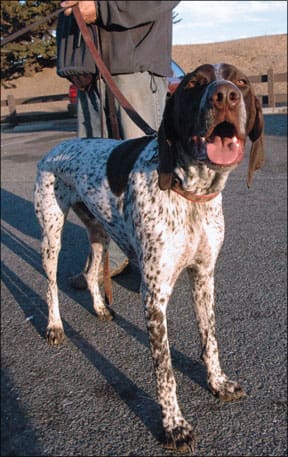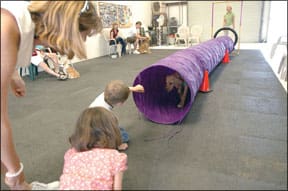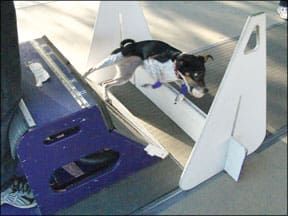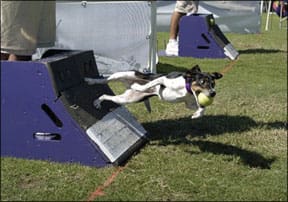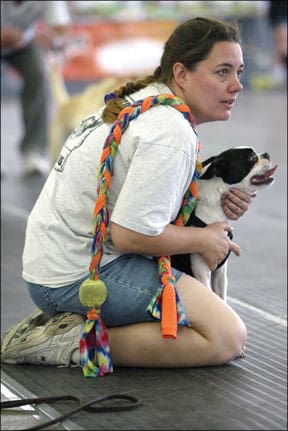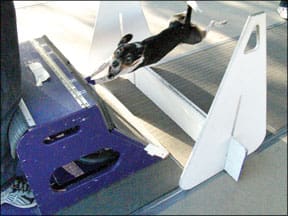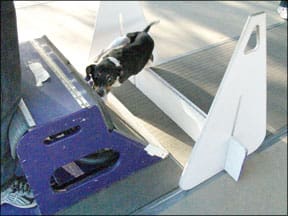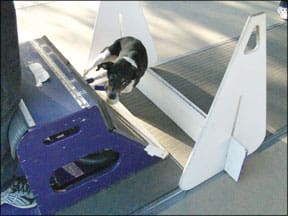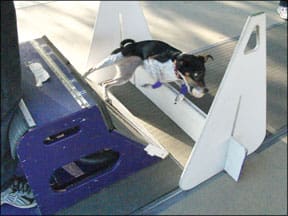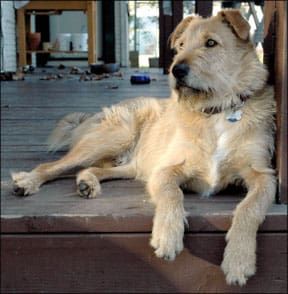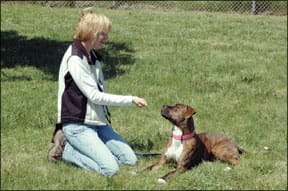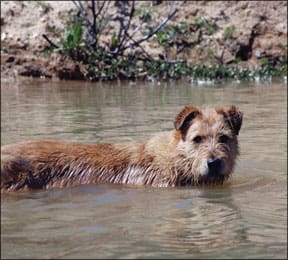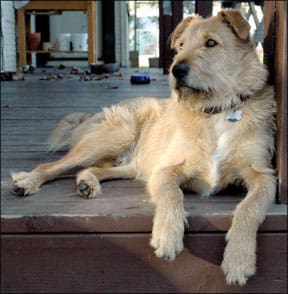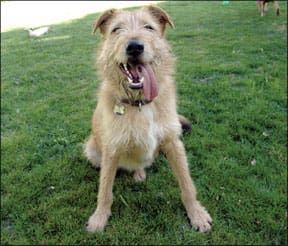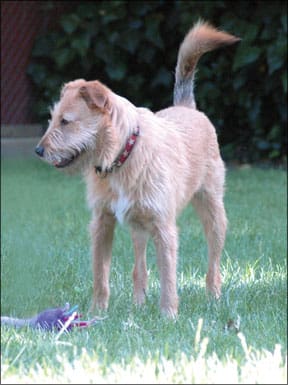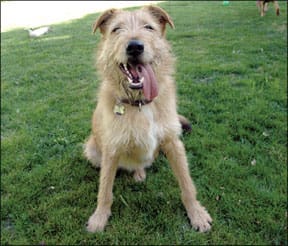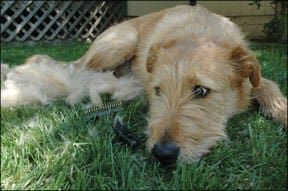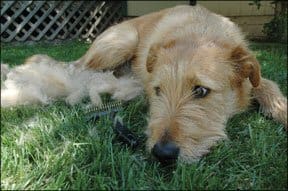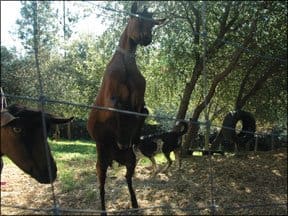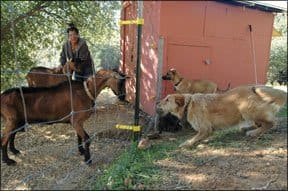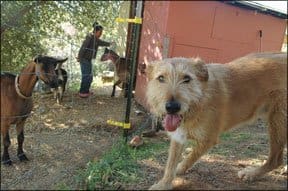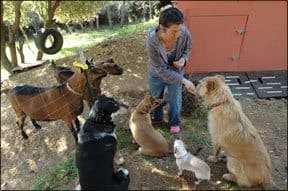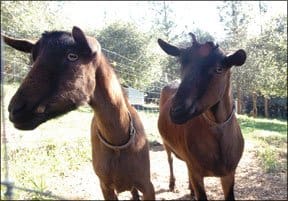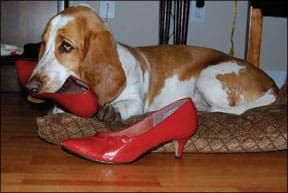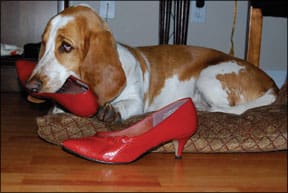DOG FOSTERING OVERVIEW
What you can do…
– Foster a needy dog or puppy if you can! But be realistic about what you are and are not able to take on.
– Make sure you thoroughly understand and agree to the shelter or rescue group’s requirements. If you don’t, you shouldn’t take one of their dogs.
– Be considerate of your own family members. It’s not fair to subject your senior dog to a rowdy pup, or your children to an aggressive dog.
Had some prescient person warned me that I would spend nearly $1,000 on vet bills; miss out on a lot of sleep; experience many worried and tearful moments (and a certain amount of marital strife); and lose untold hours on observing, training, shopping for, and cleaning up after that puppy I was considering taking home as a foster; would I still have done it?
Ah well, it’s a moot point. I did bring a puppy home from my local shelter, with the intention of spending a week or so socializing him to the world of humans (which he seemed to have little experience with), and then sending him back to the shelter to find a terrific forever home. And while I never sent him back to the shelter, I did find him a really wonderful forever home, so the story ends happily. I’m glad I did what I did, and I would love to foster another dog or puppy again someday. Knowing that I made a life-or-death difference for that one darling puppy still fills me with a warm feeling of satisfaction.
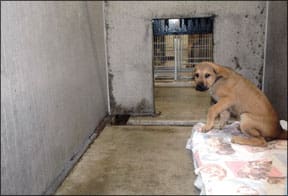
But, to be perfectly honest, I’d want to be much better prepared before I fostered again. It was an experience I could barely afford – financially, emotionally, and in terms of the time I could spent on the pup. I made it work, but the experience took its toll. I’d want to be far more prepared next time, so as to maximize the joys and minimize the perils of the undertaking.
My loss, your gain? Allow me to give you some helpful tips, in case you are thinking about providing a rehabilitative home, albeit a temporary one, for a needy dog or puppy. I can now share my own experiences, as well as those of a number of other foster providers (see below). If you are properly prepared for some of the worst things that can occur while fostering, you can prevent many of them, or at least be ready to deal with them in a graceful way. And that will make the joy of a successful fostering experience that much richer.
The Goals of Fostering
The idea behind fostering is simple: to provide a temporary home for a dog in need of a lifelong, loving, responsible home. But there is a lot to it, if you do it right. The goal is to help the dog become as healthy as possible — physically, behaviorally, and emotionally – so he’ll be a star in his new home, and (one hopes) never require rehoming again. Here is a partial list of the things that a foster provider should be trying to accomplish in order to help the dog find a solid position in an appropriate “forever” home:
Physical health. Dogs with any sort of health problem will need special help and time to recover; individuals with digestive or skin problems, in particular, are hard to find homes for. A foster provider who can spend the time needed to diagnose and successfully treat a chronic problem like food or environmental allergies is worth her weight in gold.
Socialization. The dog should gain positive experiences with a wide range of humans, including babies, kids, seniors, and people of different races. He should also be exposed to other dogs and puppies. Poor responses (fear, aggression) should be noted and improved through counter-conditioning and desensitization.
Management and supervision. The foster dog should have adequate supervision so as to prevent him from being allowed to practice undesirable behaviors that could damage his potential for placement.
House-training. The foster provider should be ready to spend whatever amount of time that it takes to provide elementary or remedial house-training for the dog; this may be a matter of days, weeks, or months, but it’s critically important. Dogs who are not reliably house-trained are very frequently returned by inexperienced owners.
Ability to be left alone. In today’s society, most dogs have to spend a certain amount of time home alone, whether it’s just for a few hours or a long work day (complete with a long commute time). Ideally, dogs and puppies should be given the opportunity to learn how to entertain and comfort themselves during alone-time in short but progressively longer increments. Food-stuffed Kongs are great tools for this purpose.
Basic training. lf a dog or puppy learns to perform just one behavior on cue – sit! – he’ll be miles ahead of most dogs that prospective adopters see in shelters. And if he knows few behaviors – such as sit, down, and come – he’ll be a genius in many adopters’ eyes. If he knows a cute trick, too, such as “sit pretty” (sitting on back end, waving front paws), “high-five,” or bowing, he’ll find a home in no time at all.
Behavior modification. In addition to counter-conditioning for fear and aggression, the foster parent is ideally willing and able to work to modify other typically unwanted behaviors such as jumping up, mouthing, excessive barking, counter-surfing, and chewing.
Who Pays for Foster Care?
Before you bring a dog or puppy home with you, it’s a good idea to find out who will end up footing the bill for his food and care. Otherwise (if you’re like me), you could end up getting so attached to and involved with your ward that you find yourself spending more than you can really afford on his rehabilitation – which might make you reluctant or unable to foster again any time soon.
Some rescue organizations pay for all the costs associated with their foster animals; their foster volunteers invest only time and love in the animals’ rehabilitation. Other groups rely heavily on their volunteers to subsidize rescue efforts. It’s smart to know before you bring a needy animal home what amount of financial support is available for your fostering efforts.
I’ve fostered twice before. Both times, I agreed to take a needy pup from a nonprofit rescue organization in the San Francisco Bay Area. This particular group rescues animals from local shelters, places them with foster providers, invests in the animals’ medical needs, and then finds them qualified homes. The organization provides food and (if needed) basic dog-care items such as collars and crates. It also manages oversight of the animals’ veterinary care, with paid staffers calling to remind foster providers to make appointments for whatever veterinary care the animal needed. It’s a model of what can be done in animal rescue.
Veterinary visits (for spay/neuter surgery, vaccinations, deworming, and the like) are provided by clinics that work closely with the rescue group; the group maintains accounts with the clinics. Had one of the foster pups become ill, I would have been able to bring the puppy to that clinic for treatment.
The staff members coordinate and track the foster animals, schedule and staff weekly adoption events in the community, manage a website with information about each available animal, and process applications for potential adopters. The staffers also do a tremendous amount of fundraising in order to pay for these very extensive efforts on behalf of a few hundred animals per year.
Many breed and dog-sport clubs run their own rescue networks that operate in a similar, but less-organized way. They keep an ear to the ground for news of dogs in need and maintain a roster of volunteers who can help assess dogs, transport them (sometimes across long distances), and provide foster care. These efforts are sometimes subsidized (in whole or part) by the volunteers themselves, and sometimes supported by the club. Most clubs that rescue dogs undertake yearly fundraising or grant-writing projects that help pay for the care and feeding of their canine guests.
Established financial support structures are critical for groups that take on a significant number of rescue dogs and that depend on repeat volunteers. Few volunteers can afford to personally subsidize extensive veterinary care or the feeding of numerous dogs. Groups that depend too heavily on their volunteers to pay for their foster animals’ care usually don’t manage to keep their volunteers for very long.
Then there are shelters, which tend to run on notoriously tight budgets. Few shelters can afford to reimburse foster providers for any extraordinary care they seek out on behalf of their charges, although there are exceptions, particularly in large cities with large pools of donors.
Like many less-well-funded shelters, my local shelter sometimes makes a project out of a really special dog who has faced extensive challenges, such as severe abuse. But I doubt that they can afford to “go to the wall” for every sick puppy in their care. Had I been completely unable to afford the care I thought the puppy needed, I knew that my shelter would have taken him back – although I’m not certain they would have given him the extensive treatment he needed to recover. I could have asked about partial reimbursement for some of my foster puppy’s medical bills. However, since I frequently donate money to the shelter, I decided that the puppy’s vet bills, instead, would constitute my good canine deed for this quarter.
Helpful Guidance or Oppressive Rules?
A prospective foster provider should also find out whether the rescue group has strict guidelines for its foster parents – or whether it offers any guidance, training, and support at all.
Some groups assume that only experienced, knowledgeable dog owners will volunteer to foster; providers are on their own to decide how the dog will be housed and trained. If their temporary wards exhibit health or behavior problems that are beyond their level of experience, they will probably have to figure out how to deal with it by themselves.
Other groups provide new foster providers with an orientation or basic training session, or give their potential foster providers a notebook full of “recommended” practices or guidelines. This may or may not be backed up with phone or e-mail support from an experienced dog owner who serves as volunteer coordinator.
Then there are the organizations that have formalized the entire fostering process; some of these won’t put a dog into the care of anyone who won’t sign an agreement that compels providers to feed and train the dog a certain way.
I’ve heard of foster groups that require dogs to be fed only the food provided by the group; without fail, these foods have been provided by dog food companies that make what I consider to be low-quality foods. Perhaps even more offensive to me is the prohibition on feeding treats of any kind, even for training purposes. (Personally, I couldn’t care for a dog without using this very powerful tool for training and behavior modification.)
And while I think the ability to be calmly crated is an incredibly important life skill for a dog to possess, I’ve learned about rescue groups that require their foster providers to crate every dog, every night – and for periods during the day, too. I understand that they are trying to ensure that potential adopters will be reasonably assured of receiving a house-trained, crate-trained dog – one that is unlikely to be returned to the rescue group.
I’ve also heard of organizations that require every foster dog to wear a headcollar, whether or not the dog needs or can be comfortably accustomed to that gear. Again, I’m not sure I could agree to such inflexible policies.
Finding the Dog a Home
It’s also a good idea to find out what the rescue group or shelter does to find homes for its wards. Some groups take total responsibility for finding and screening potential adopters. Ideally, they run public adoption events; display promotional fliers at local vets, pet supply stores, and dog parks; and maintain an attractive and frequently updated website; and share their list of adoptable animals with Petfinder.org and other sites.
Even if the rescue group takes responsibility for finding an adopter for your foster dog, you will probably be expected to host “interviews” between the dog and prospective adopters, and to transport the dog to and from various adoption events.
This might sound like a lot of work for you, but groups that do less to promote their adoptable dogs may rely on you to do even more. Many rescue groups do a poor job of promotion and marketing of their adoptable animals, and some rely almost solely on their foster providers to find homes for their wards.
Ask the foster coordinator about the efforts that will be made to find a home for your ward. Make sure you understand what the group expects you to do to help find a lifelong, loving home for your canine foster, and that you can meet those expectations.
Extraordinary Support
Well-established rescue organizations generally have policies and support in place to address whatever sort of emergency might arise with a dog in foster care. In many other cases, though, providers may be left to their own judgment and resources to deal with the emergency.
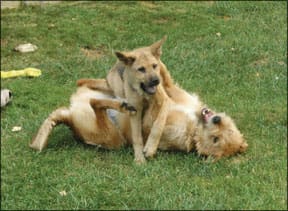
I’ve talked about vet bills for the foster dog, but what about your own dog? Are you prepared to pay the bill if your foster ward infects your pet, necessitating a trip to the vet (or hospitalization) for your dog? A friend told me recently about a vet bill she had to pay when a dog she was fostering for a rescue group attacked her dog, who needed stitches, drains, antibiotics, and extended care.
As my friend’s story illustrated, health problems are not the only emergency that can develop with a foster dog. Serious behavior problems can crop up without previous warning, resulting in a painful bite (or deadly attack) on your own dog, cat, kid, or self.
It may develop that a foster dog has serious behavior problems; many dogs seem to be well-behaved individuals when they are, in fact, so stressed by their changing environment that they are actually “shut down,” responding in a slow, deliberate manner. Sometimes when these dogs become comfortable in a home and begin to relax, they may begin to exhibit behaviors that are beyond the ability of the foster provider to address.
Ideally, a rescue organization or shelter will have ready access to a really experienced positive trainer or behavior professional who can offer further assessment, advice, and support. Be advised, however, that this sort of backup is rare; you may be on your own with serious behavior problems. Which brings me to the final thing to ask about before bringing your foster dog home . . .
Right of Return
Keep it in mind that any foster parent, no matter how experienced, can become overwhelmed by the extraordinary needs of a deeply troubled dog or puppy. Make sure that the rescue group or shelter can take back your foster dog if you find yourself in dire straits.
Remember, you have a responsibility to your own family to consider, too. Despite your best efforts to prevent it, your sick puppy may infect your own dog, and leave you nursing two dogs. (This happened to me, too; Otto “caught” my foster puppy’s “kennel cough.” As a healthy adult dog, he didn’t get very sick, but he had a horrible, raspy cough for a week or so. It was loud enough to prompt several of our neighbors to ask whether he was choking!)
Unintentionally facilitating a foster dog’s aggressive attack on one of your own family members – human, canine, or feline – would be even worse.
As upsetting as it can be for any well-intentioned dog lover to feel forced by circumstances to return a foster dog, it’s even more disturbing when the rescue group lacks the ability to provide a back-up placement. Being stuck with a dog who puts you, your pets, or your family members in jeopardy may well turn you away from fostering ever again.
Beware organizations or individuals who pressure foster parents to “stick it out a little longer,” no matter what problem their foster dog is exhibiting. In some cases, they may be counting on the foster provider to “fall in love” with the dog and adopt it. Many of us have good reasons for wanting to provide foster care, rather than adopting another dog. Groups that take advantage of their foster providers in this way soon find themselves without foster providers.
“The Most Selfless Thing You Can Do for a Dog” — Fostering Stories
Chris Danker, CPDT, of Albany County, New York, has fostered for more than 30 years. “Fostering is more then taking the dog into your home. It is spending quality time with the dog, exposing her to as many situations as possible. I hear stories of foster providers who have dogs living in crates until the ‘right home’ comes along. That is not fostering; it’s warehousing.”
She warns: “When fostering, be ready for anything. The progress these animals make is worth seeing. Be ready to give up your time, sleep, and probably some money.”
Liz Marsden, CPDT, trains in Washington, DC, and Connecticut, and says she has been a “serial foster provider” for many years. “What would I warn people about? Be careful when you say you will foster; you might just end up with 10 or 15 dogs who are former fosters and now yours!”
Leslie Fisher is a positive trainer in Maryland who describes herself as a “failed foster” – meaning she ended up adopting each of the three dogs she originally took on as fosters. “Bridget CGC and Talley are much loved and they both help in my business. Recently I became involved with the Lab Rescue of the Potomac Valley, which is how I met four-year-old Doobie. I think he was a foster for all of 12 hours before I knew he needed to be part of my pack. If you are like me, you cannot help but become emotionally attached during the nurturing process. However, fostering is the most selfless, wonderful thing you can do for a needy dog.”
Saving a life, and making a family happy, are some of the reasons that Seattle resident Dana Mongillo fosters dogs and cats. “One of my first foster experiences, Shelby, was an 11-year-old shepherd-mix with ACL and hip issues plus pneumonia; her age and health would have made her an easy euthanasia at a lot of shelters, but the Seattle Animal Shelter thought there might be a forever home out there for her, and there was! She was with us for six months before we found the ideal family. It was hard to say goodbye, but once we found the right home it felt like the right thing to do.
“Tigger, a Border Collie/Rottie-mix, came to us at nine months. He was wild, but with tons of exercise he turned into a nice dog. We found a great family for him within weeks. Two years later I saw him back at the shelter! I fostered him again, but exercise did not help this time; he now had severe separation anxiety. I found this out when I left him alone in the car at the grocery store. He attacked the dashboard and seats and took chunks out of all four door panels. It was my husband’s car, so I had a lot of explaining to do that night!
“Tigger was a charming, friendly dog, but very anxious when left alone. We had a dozen interviews for him in five months, but once people would see him in his anxious state, it was over. He is now a cherished member of our family – the sweetest, goofiest guy. We can’t imagine life without him!
“Watching your foster dog jump into the car to drive off with his new family is bittersweet but ultimately happy. Every foster dog that you place leaves a space in your home for you to help another dog in need!”
Frequent WDJ contributor Mary Straus shares, “About 15 years ago, I agreed to foster a one-year-old blind Shar Pei for what I thought was to be just a few days. The person who does Shar-Pei rescue in my area was going away for that long and my understanding was that she would take him when she got back. That didn’t turn out to be the case.
“The good part is that it changed my view of blind dogs forever. It was amazing how well Pumpkin got around. The problem was that I already had two dogs, and I didn’t want a third. I waited for almost two months for the rescue person to find a home for him. She finally admitted that she wasn’t really looking to find him a home because she was hoping that I would adopt him. I felt she had used me and been dishonest with me from the beginning. I ended up making her take him back herself (something I feel guilty about to this day), because that seemed to be the only way she would ever find him a home. In the end it worked out. He was adopted by folks I had met at my vet’s office, but the whole thing left a bad taste in my mouth. And it was dumb, because good foster providers are a lot harder to find than good adopters.”
In Ohio, Bonnie Becker has fostered Cairn Terriers “almost continuously” for the Colonel Potter Cairn Rescue Network since 2001. “One memorable foster was the nine-year-old female turned over to a shelter by a ‘rescue group’ that bought her at auction from a puppy mill. She had been burned, probably by a defective heating pad in her cage, and had gone for some time without treatment. One of our volunteers is a long-haul trucker who picked her up and took her to a vet in Chicago for treatment. Her skin had been damaged for so long that the vet didn’t know whether enough healthy skin would be left to pull over the area after the dead skin was debrided away. Her treatment exceeded $2,000, but we were able to save her and she became a real beauty. She’s living in Georgia now and gets walks along a river there where there are many birds, squirrels, and other small critters for her to enjoy seeing.
“To anyone considering fostering: Go for it. It’s a wonderful, life-changing experience, and a great way to give back. My lifelong friends in rescue support each other in bad times and cheer with each other in good times.”
Lesley Bastian, of Annapolis, Maryland, has volunteered at the SPCA ofAnne Arundel County for six years. She recently enjoyed her first fostering experience. “I am still giddy! I was fortunate enough to foster a momma Pit/Lab-mix and her eight puppies for two weeks in April. One of those puppies had kennel cough and had to stay with me for an additional two weeks. She had a typical puppy disposition and the energy to go with it, and I showered her with love and attention while she was here. I’ve done many fun things in my life, but I think this has been one of the most rewarding so far.”
Bastian said it was difficult to return the dogs to the shelter to find homes, but says she realizes that “the shelter is a stepping stone into their future. I trust that my shelter has the best interest of the animals at the core of their operation. If I didn’t believe that, I couldn’t have returned my pups.”
Nancy Kerns is Editor of Whole Dog Journal.


